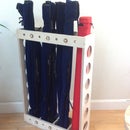Introduction: Shoe Bench Made With CNC Router and Laser
Here is a shoe storage bench for an entryway. It was cut from 3/4, 1/2 and 1/8 inch plywood with a CNC router and laser cutter.
The goal of this design was a rigid, light bench. It must also be strong enough to stand on, and have good ventilation properties for the shoes. The person requesting the bench wanted the shoes to be concealed from view when facing the back (this bench was not going to be placed against a wall.)
This build was also an experiment using a combination of blind mortises and pocket screws for construction.
Step 1: Tools and Materials
Tools:
- CNC router
- Router bits ( 1/4 upcut, 1/4 downcut, 1/8 mortise) bit
- Pocket screw kit (jig, drill driver)
- Clothes iron (for edge banding)
- Edge band trimmer
- screwdriver (electric)
- 3 foot bar clamps (4)
- Paint brushes
- Finish sander
Materials:
- 3/4 plywood (1/2 sheet with plenty of leftover)
- 1/2 plywood (1/4 sheet)
- 1/8 plywood (18x 24 inch)
- veneer edge band (20 feet)
- wood glue
- pocket screws mostly 1 inch and some 1 1/4 inch
- 220/350 grit sandpaper
- furniture finish (I used water based polyurethane)
Step 2: Design
The person requesting this bench specified that it be narrow, under 2 feet long and hold as many low profile shoes as possible. So I opted for three shelves.
I also wanted to try a combination of blind mortises and pocket screws. The mortises would add strength and ensure an accurate and speedy assembly, while the pocket screws provided a strong reliable joint with zero wait time on gluing and clamping.
I also tried a combination of up and down spiral router bits to improve the odds of a clean cut on both facesof the plywood. This enabled me use a design that had blind mortises (the inside face has to be up on the router table, so the eventual outside face at the bottom of the plywood has to be cut cleanly).
I used a laser cut lattice in the plywood back face to facilitate bending of the plywood without steaming or wetting, and also to improve ventilation. The lattice design is just a repeated rectangle with circular corner cutouts. By aligning the rectangles, it creates a circle/spoke pattern.
Step 3: Cutting
I used the 1/8 bit to cut the pocket for the 1/8 plywood backing
I used the 1/4 downcut bit for the mortices and 90% of the profile depth
I finished the profile with the upcut bit.
For the plywood lattice back, I applied a single layer of varnish, and after the varnish dried, applied a layer of painters tape to the outside. I placed the outside down on the laser and vector cut the lattice in two passes.
Step 4: Assembly
- Iron on and trim the edge banding.
- Using the pocket screw jig, drill the pockets.
- Sand and finish the parts, taking care not to apply finish on any surfaces that will be glued.
- Dry fit the entire assembly
- Remove and reassemble with glue and pocket screws. Use bar clamps to ensure that the parts are flush. The clamps can be removed after the screws have been tightened
Step 5: Finish and Test.
apply any finish touch ups, and give the bench a test drive.
That's it!
Step 6: Restropective
The blind mortise/pocket screw combo worked very well. The whole thing just snapped together, perfectly aligned. I will use this technique again for future projects.
The piece was actually quite rigid with just a dry fit, so I might have been able to get away with just mortises. So for those of you that abhor pocket screws, this might be an option.
The combo of downcut and upcut router bits worked nice with negligible tearout. It only takes a minute or so to change bits. Downcut only caused some pretty ugly tearout on the bottom, resulting in a redo of the shelf cuts.
Design-wise, A reviewer made a good point that the design does not work as well in wet climates where the shoes may drip water. A future design should be dimensioned to allow a standard sized food serving tray or similar product to be slid under the lowest shelf to catch any water. I also think more interesting lattice pattern might have worked better.













